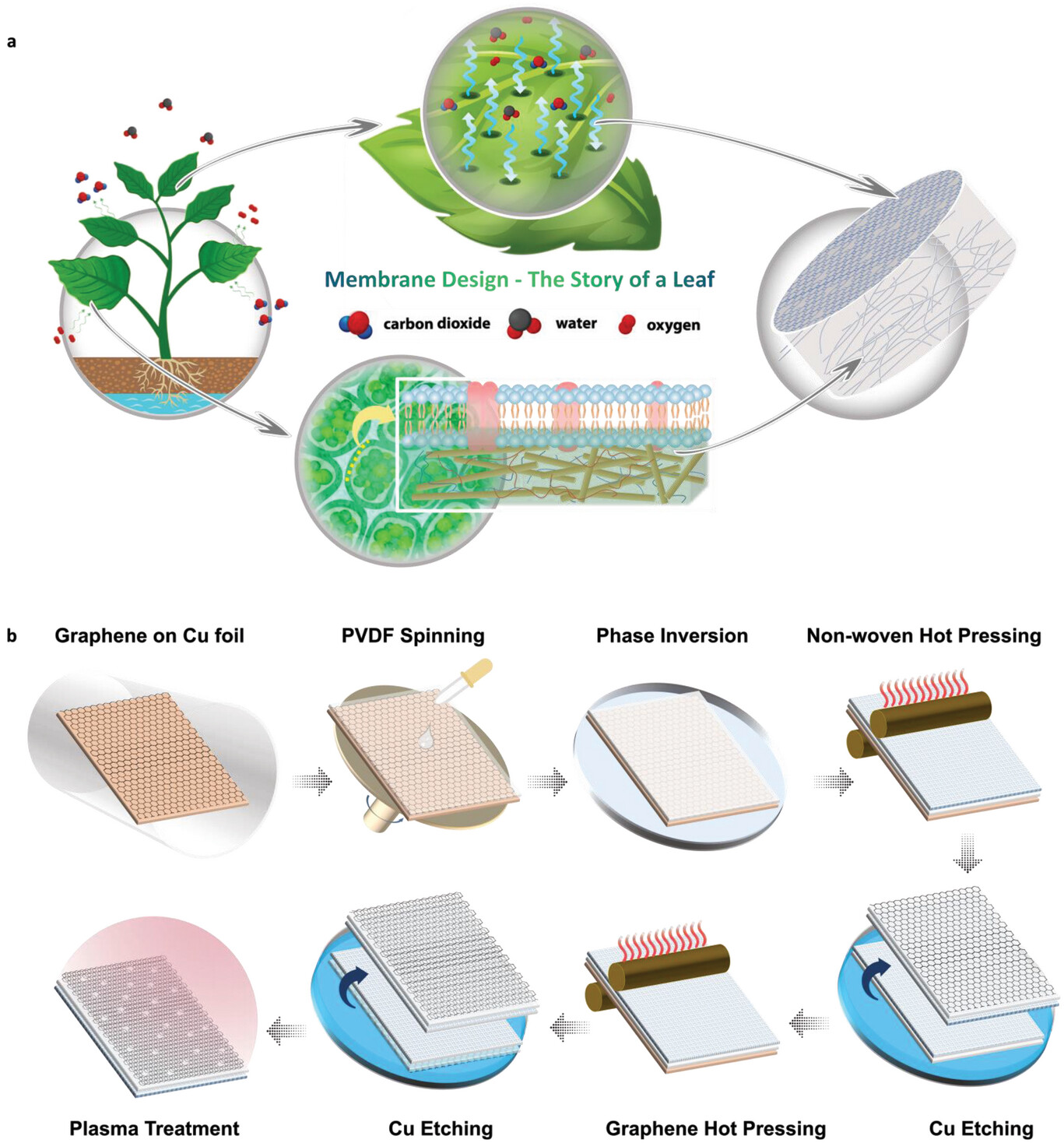| Nov 14, 2023 | |
Bioinspired reinforced graphene membranes overcome mechanical limitations |
|
| (Nanowerk Spotlight) For decades, researchers have sought to develop membranes that can effectively filter water while minimizing energy consumption. Such membranes would enable energy-efficient desalination to produce fresh water from seawater or wastewater. This could help provide clean drinking water amid growing water scarcity. | |
| However, current membrane materials like polymers traditionally face an inherent tradeoff between permeability and selectivity. Highly permeable membranes tend to be less selective, allowing unwanted dissolved particles to pass through. Meanwhile highly selective membranes are less permeable, requiring substantial pressure and energy to push water through. | |
| Scientists have proposed atomically thin, porous graphene as an ideal membrane material to break this tradeoff. With suitable nanopores, graphene's unique 2D structure should enable extremely fast permeation yet precise selectivity down to the molecular scale. But translating this promise into practical large-area membranes has proven enormously challenging. | |
| Graphene membranes are too fragile in their raw monolayer form, prone to tearing and clogging. Thus, graphene must be transferred onto porous substrates for mechanical support and module integration. However, this risks defects forming between layers, degrading graphene's separation performance. The resulting membranes also demonstrate poor resistance to pressure, bending, tension, and handling. Their limited mechanical strength hinders scalable fabrication and device integration. Without enhancements, graphene membranes remain unsuitable for real-world deployment. | |
| Against this backdrop, researchers from Peking University, Beijing Normal University and KU Leuven recently reported a novel method to substantially reinforce large-area graphene membranes. Published in Advanced Functional Materials ("Bioinspired Large-Area Atomically-Thin Graphene Membranes"), their work represents significant progress towards robust graphene membranes for practical water purification. | |
 |
|
| a) Designed structural model of the composite membrane. b) Schematic illustration of the process used to fabricate NGCMs. First, single-layer graphene samples were grown through a CVD method. Then, the PVDF-DMAc solution was coated onto the graphene and placed in a water bath to form the PVDF layer. Next, the nonwoven reinforced layer was composite to the PVDF layer by hot pressing. Subsequently, the copper was etched away to form the graphene/PVDF/nonwoven composite membrane and then clung to another graphene sample to obtain the double-layer graphene composite membrane after repeating the above hot-pressing and etching processes. Finally, Plasma etching was employed to induce nanopores in the double-layer graphene surface. (Reprinted with permission from Wiley-VCH Verlag) | |
| The researchers drew inspiration from plant cell biology. Plant cells are wrapped in a sturdy composite structure with the cell membrane surrounded by the fibrous cell wall. This provides mechanical strength to withstand osmotic pressure gradients for water transport. Adapting such bioinspired principles, the team sandwiched graphene between a nanoscale polymer adhesion layer and a porous nonwoven support matrix. | |
| This composite reinforcement enhanced the graphene membrane's fracture stress and strength by factors of 17 and 67 respectively compared to previous graphene membranes. The membrane's stiffness rose 94-fold. Tests demonstrated stability across repeated bending and handling. Unlike past attempts, no tears formed even at extreme curvature. The membrane withstood over 10,000 bending cycles with high graphene coverage retained, far exceeding typical polymer films. The surprisingly robust performance results from synergies between the polymer intermediary layer and fibrous network support matrix surrounding the mechanically fragile graphene. | |
| To enable selective molecular transport, the team introduced nanopores into the graphene via argon plasma etching. Tests revealed the nanoporous graphene membrane completely blocked liquid water permeation up to 5 bar pressure. This extraordinary impermeability results from water's surface tension within graphene's angstrom-scale pores. Yet the membrane demonstrated a remarkably high gas permeation over 6 orders of magnitude greater than commercial polymer films. | |
| Specifically, the graphene membrane exhibited an ultra-high gas permeance of 8.6-23 L m-2 d-1 Pa-1 along with an exceptionally low water vapor transportation rate of 23-129 g m-2 d-1. This adjustable "breathing" performance mirrors stomata in plant leaves. Varying the plasma process tunes the nanopore density to tailor permeability as needed for different separations. | |
| The team's novel reinforced graphene membrane architecture overcame Achilles' heels that have long hindered real-world application of these promising materials. The improved scalable fabrication method and module integration capability mark a major milestone for deploying graphene membranes. | |
| Looking ahead, the approach could be adapted for different 2D materials like molybdenum disulfide to expand options for membrane materials with desirable separation capabilities. The researchers underscored that their robust graphene membranes still require further development and testing before commercial viability. Nonetheless, their trailblazing work provides a critical foundation and opens exciting prospects for next-generation membranes to make water purification far more energy efficient. | |
 By
Michael
Berger
– Michael is author of three books by the Royal Society of Chemistry:
Nano-Society: Pushing the Boundaries of Technology,
Nanotechnology: The Future is Tiny, and
Nanoengineering: The Skills and Tools Making Technology Invisible
Copyright ©
Nanowerk LLC
By
Michael
Berger
– Michael is author of three books by the Royal Society of Chemistry:
Nano-Society: Pushing the Boundaries of Technology,
Nanotechnology: The Future is Tiny, and
Nanoengineering: The Skills and Tools Making Technology Invisible
Copyright ©
Nanowerk LLC
|
|
|
Become a Spotlight guest author! Join our large and growing group of guest contributors. Have you just published a scientific paper or have other exciting developments to share with the nanotechnology community? Here is how to publish on nanowerk.com. |
|
